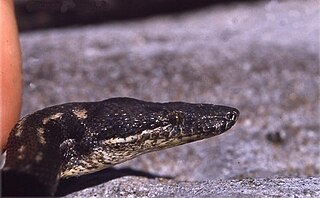
The Bolyeriidae are a family of snakes native to Mauritius and a few islands around it, especially Round Island. They also used to be found on the island of Mauritius, but were extirpated there due to human influence and foraging pigs in particular. These snakes used to be placed in the Boidae, but are now classed as a separate family. Two monotypic genera are recognized, but only a single species is extant. Bolyeriidae appear to be most closely related to the Asian genus Xenophidion.

Xenopeltis, the sunbeam snakes, are the sole genus of the monotypic family Xenopeltidae, the species of which are found in Southeast Asia. Sunbeam snakes are known for their highly iridescent scales. Three species are recognized, each one with no subspecies. Studies of DNA suggest that the xenopeltids are most closely related to the Mexican burrowing python and to the true pythons (Pythonidae).

The Calabar python is a species of non-venomous snake in the family Boidae. The species is endemic to West and Central Africa. It is the only species in its genus.

Eryx johnii is a species of nonvenomous snake in the subfamily Erycinae of the family Boidae. The species is endemic to Iran, Pakistan, and India. There are no subspecies which are recognized as being valid.

Eryx conicus, also known as Russell's sand boa, the Common sand boa or the rough-tailed sand boa, is a species of non-venomous snake in the subfamily Erycinae of the family Boidae. The species is native to Southern Asia. No subspecies are recognised.
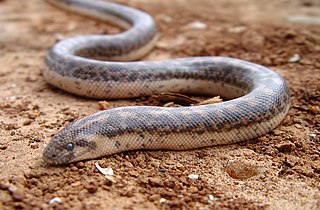
Eryx is a genus of nonvenomous snakes, commonly known as Old World sand boas, in the subfamily Erycinae of the family Boidae. Species of the genus are found in southeastern Europe, northern Africa, the Middle East, and southwestern Asia. Thirteen species are recognized as being valid.

Acrantophis madagascariensis is a species of boid snake in the subfamily Sanziniinae that is endemic to the island of Madagascar. Its common names include the Madagascar ground boa and Malagasy ground boa.

Tropidophis melanurus, commonly known as the dusky dwarf boa, Cuban wood snake, or Cuban giant dwarf boa, is a nonvenomous dwarf boa species found mainly in Cuba. There are three subspecies that are recognized as being valid, including the nominate subspecies described here.
Eryx elegans is a boa species endemic to western Central Asia. Like all other boas, it is not venomous. No subspecies are recognized.

The amethystine python, also known as the scrub python or sanca permata in Indonesian, is a species of non-venomous snake in the family Pythonidae. The species is found in Indonesia and Papua New Guinea. Popular among reptile enthusiasts, and noted for its coloration and size, it is one of the largest snakes in the world, as measured either by length or weight, and is the largest native snake in Papua New Guinea. Until 2000, the larger S. kinghorni was generally considered a subspecies of S. amethistina, and this change of classification has still not been universally reflected in literature. Because of this issue, S. amethistina has often been described as the largest snake in Australia, but this is not accurate since under the current classification, this species does not occur in Australia.
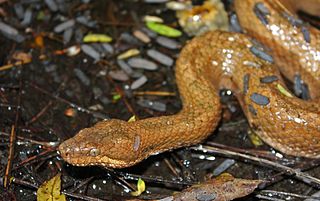
Tropidophis, common name Caribbean dwarf boas, wood snakes or West Indian wood snakes, is a genus of dwarf boas endemic to the West Indies and South America. Currently, either 17 or 33 species are recognized, depending on the authority.

Corallus cookii, also known as Cook's tree boa or Cooke's tree boa, is a species of nonvenomous snake in the family Boidae. The species is endemic to the island of St. Vincent in the Caribbean. There are no recognized subspecies.

The Round Island boa, also known commonly as the Round Island keel-scaled boa and the Round Island ground boa, is a species of nonvenomous snake in the monotypic genus Casarea in the family Bolyeriidae. The species is endemic to Round Island, Mauritius. No subspecies are currently recognized.

Eryx colubrinus, the Egyptian or Kenyan sand boa, is a species of snake in the family Boidae. The species is endemic to Northern and Eastern Africa. Three subspecies are recognized.
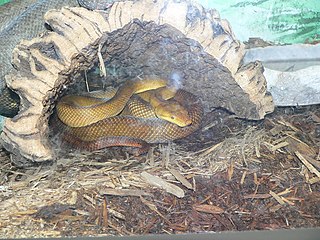
Candoia bibroni, commonly known as Bibron's bevel-nosed boa, Bibron's keel-scaled boa, the Pacific tree boa, or the Fiji boa, is a boa species endemic to Melanesia and Polynesia. Two subspecies are recognized, including the nominate subspecies described here. Like all other boas, it is not venomous.
Trachyboa gularis, commonly known as the Ecuadorian eyelash boa, is a species of nonvenomous snake in the family Tropidophiidae. It is endemic to Ecuador, and is only known from an area where suitable habitat has been almost completely destroyed. Recent confirmed records are also lacking, and the IUCN has concluded that Trachyboa gularis is a possibly extinct species.
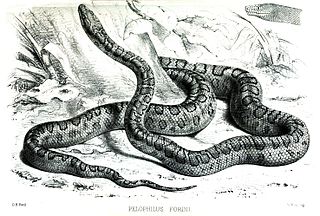
Chilabothrus fordii, also known commonly as Ford's boa and the Haitian ground boa, is a species of snake in the family Boidae. There are three recognized subspecies.

Eryx jaculus, known commonly as the javelin sand boa, is a species of snake in the Boidae family. It is the type species of the genus Eryx.
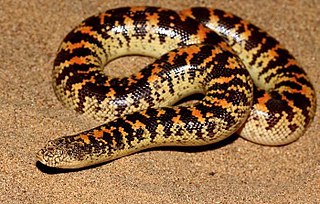
Eryx jayakari, known commonly as the Arabian sand boa or Jayakar's sand boa, is a species of snake in the family Boidae. The species is endemic to the Arabian Peninsula and Iran where it spends the day buried in the sand.
















